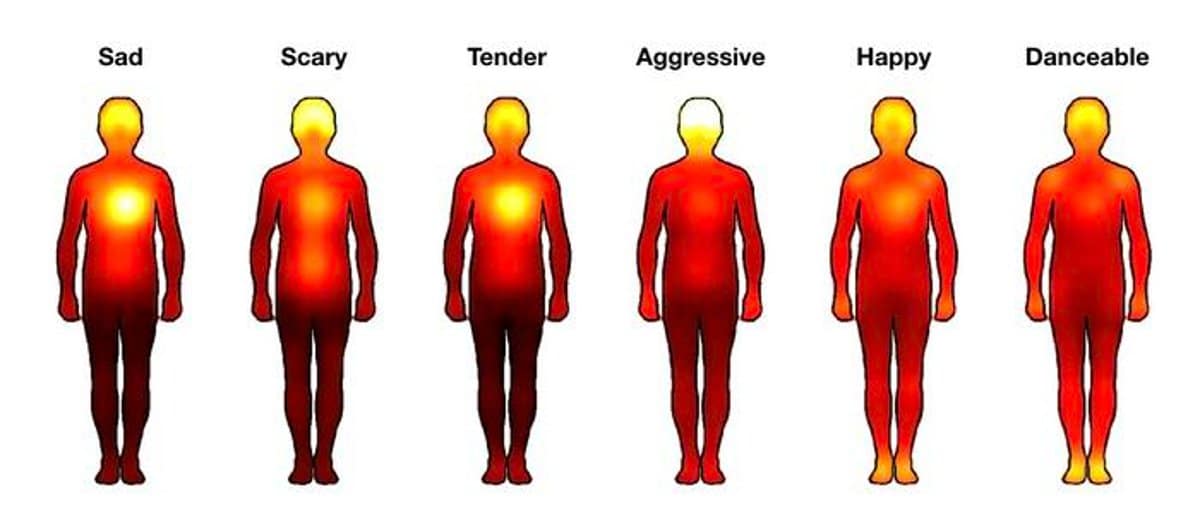
Summary: According to a recent study, music can evoke similar bodily sensations and emotions across different cultures. The study involved 1,500 participants from the West and Asia and examined how certain types of music can lead to uniform emotional and physical responses. The study suggests that music’s ability to unify emotions and movements may have contributed to human evolution by fostering social bonds and community.
Key Facts: Emotional music can produce similar bodily sensations across Western and Asian cultures. The study, with 1,500 participants, suggests that music’s influence is likely based on biological mechanisms that transcend cultural learning. Music’s capacity to synchronize emotions and physical responses across listeners may have evolved to enhance social interaction and community.
Source: University of Turku
Music has a direct impact on the body. When people hear music they love, they often feel the urge to move along with it. Music has the ability to activate the autonomic nervous system and even provoke shivers down the spine. A new study from the Turku PET Centre in Finland has shown how emotional music can evoke similar bodily sensations across different cultures.
“Music that elicits different emotions, such as happiness, sadness, or fear, causes different bodily sensations in our study. For example, happy and upbeat music is felt in the arms and legs, while tender and sad music is felt in the chest area,” explained Academy Research Fellow Vesa Putkinen. Music can evoke similar emotions and bodily sensations in Western and Asian listeners. Credit: Lauri Nummenmaa, University of TurkuThe emotional and bodily sensations brought about by music were consistent across Western and Asian listeners. These bodily sensations were also associated with the emotions induced by the music.
“Certain acoustic features of music were linked to similar emotions in both Western and Asian listeners. For example, music with a clear beat was associated with happiness and danceability, while dissonant music was linked to feelings of aggression,” said Professor Lauri Nummenmaa.
“Since these sensations are similar across different cultures, music-induced emotions are likely independent of culture and learning, and are based on inherited biological mechanisms,” Nummenmaa added.
“Music’s impact on the body is universal. People across all cultures move to music, and synchronized postures, movements, and vocalizations are a universal indicator of affiliation.
“Music may have emerged during human evolution to enhance social interaction and a sense of community by synchronizing the bodies and emotions of the listeners,” Putkinen further explained.
The study was carried out in collaboration with Aalto University from Finland and the University of Electronic Science and Technology of China (UESTC) as an online questionnaire survey. A total of 1,500 Western and Asian participants evaluated the emotions and bodily sensations evoked by Western and Asian songs.
Funding: The study was funded by the Research Council of Finland. About this music and emotion research newsAuthor: Tuomas Koivula
Source: University of Turku
Contact: Tuomas Koivula – University of Turku
Image: The top image is credited to Neuroscience News. Lauri Nummenmaa, University of Turku is credited for the image in the article.
Original Research: Open access.
“Bodily maps of musical sensations across cultures” by Lauri Nummenmaa et al. PNASAbstractBodily maps of musical sensations across culturesEmotions, bodily sensations and movement are integral parts of musical experiences. However, it remains unknown whether emotional connotations and structural features of music elicit distinct bodily sensations and whether these sensations are culturally consistent. These questions were addressed in a cross-cultural study involving Western (European and North American, n = 903) and East Asian (Chinese, n = 1035) participants. They were presented with silhouettes of human bodies and asked to indicate the bodily regions whose activity they felt changing while listening to Western and Asian musical pieces with varying emotional and acoustic qualities. The resulting bodily sensation maps varied according to the emotional qualities of the songs, particularly in the limb, chest, and head regions. Music-induced emotions and corresponding bodily sensation maps were consistent across Western and East Asian subjects. The music’s acoustic and structural features were consistently associated with emotion ratings and music-induced bodily sensations across cultures. These findings emphasize the significance of subjective bodily experience in music-induced emotions and demonstrate consistent associations between musical features, music-induced emotions, and bodily sensations across distant cultures.










